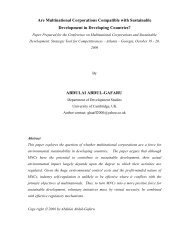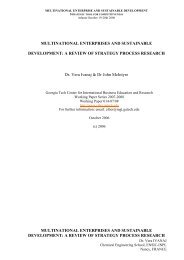AMD vs Intel: Technology, Competition, and Sustainability
AMD vs Intel: Technology, Competition, and Sustainability
AMD vs Intel: Technology, Competition, and Sustainability
Create successful ePaper yourself
Turn your PDF publications into a flip-book with our unique Google optimized e-Paper software.
dem<strong>and</strong>. 4 If either duopolist developed a more powerful or cheaper chip <strong>and</strong> increased<br />
dem<strong>and</strong>, the one with greater unused capacity would be able to supply the dem<strong>and</strong>, while<br />
the one without excess capacity could not.<br />
IBM delayed adopting the i386 for a year, <strong>and</strong> Compaq became the biggest PC<br />
seller. <strong>Intel</strong>’s slogan of “<strong>Intel</strong> Inside” led users to identify the microprocessor as the key<br />
part of the PC. What mattered was the br<strong>and</strong> of chip not the br<strong>and</strong> of the box. As 386<br />
competition arose, <strong>Intel</strong> started paying half of its OEM <strong>and</strong> merchant advertising costs for<br />
<strong>Intel</strong>-equipped products. Big computer retailers <strong>and</strong> br<strong>and</strong>s would feature their <strong>Intel</strong><br />
products (for which they got rebates <strong>and</strong> ignore <strong>AMD</strong>. <strong>AMD</strong> never seemed to pay<br />
rebates. There were no old x86’s PC’s that could compare with those using the i386. The<br />
part had come to dominate the whole. The clone makers did nothing to improve the PC,<br />
<strong>and</strong> <strong>Intel</strong> took increasing control of the computer’s interior, introducing the PCI bus<br />
which increased overall speed by four or five times, <strong>and</strong> permitted the new, faster chips<br />
to perform up to capacity. <strong>Intel</strong> began markerting chip sets <strong>and</strong> mother boards, increasing<br />
its share of value added.<br />
The faster i486 (1989) dominated the PC industry until 1993, even though other<br />
companies later introduced 486s.<br />
In 1993, <strong>Intel</strong> introduced the faster technologically-advanced Pentium. A math<br />
professor discovered <strong>and</strong> explained an error in the floating point unit, <strong>and</strong> disclosed it an<br />
Internet newsgroup whence it rapidly spread to the headlines. <strong>Intel</strong> had discovered the<br />
same defect earlier, <strong>and</strong> had decided that it was not bad enough to recall the defective<br />
parts -- an astonishing blunder. The defects were repaired in future steppings of the chip,<br />
but when the “floating point error” became public there was a storm of criticism. IBM<br />
stopped selling Pentiums for the time being. Memories are long, <strong>and</strong> <strong>Intel</strong> haters keep up<br />
complaints to this day. <strong>Intel</strong> finally got it offered replacements, first to serious math<br />
users, <strong>and</strong> later to every purchaser. <strong>Intel</strong> took a $475 million charge to cover the recall,<br />
<strong>and</strong> lost much prestige but had the best year in its history. There was no rival to the<br />
Pentium until <strong>AMD</strong>’s answered in 1005 with the <strong>AMD</strong> 586 K5.which some brilliant<br />
design ideas but was poorly executed. Meanwhile, <strong>Intel</strong> developed the P-6 or Pentium<br />
Pro. <strong>AMD</strong> acquired NexGen, (started by former <strong>Intel</strong> engineers who had helped design<br />
the Pentium). The NexGen team developed the <strong>AMD</strong> K6. It was successful technically<br />
<strong>and</strong> commercially. It saved <strong>AMD</strong>. It was superior technically to the Pentium <strong>and</strong> cheaper<br />
than <strong>Intel</strong> Pentium II. Capacity limited, <strong>AMD</strong> contracted to build <strong>and</strong> operate Fab 30 in<br />
Dresden as part of an integrated semiconductor initiative in former East Germany. It<br />
joined all the right clubs <strong>and</strong> begged large subsidies as befitting a German Company. The<br />
next years were filled with vigorous competition. <strong>Intel</strong> introduced the successful Pentium<br />
II, based on the P6 architecture in 19977, Both the PII <strong>and</strong> <strong>AMD</strong>’s K6 went through<br />
speed upgrades, as the transistor <strong>and</strong> line width were reduced, <strong>and</strong> production moved<br />
from 150 mm wafers to 200 mm wafers in the new fabs that both companies built. <strong>AMD</strong><br />
usually lagged a year or so in the new technologies, but its chips drew closer to <strong>Intel</strong> in<br />
speed <strong>and</strong> performance. The Pentium III, introduced in 1999 <strong>and</strong> went through speed<br />
upgrades but suffered from the dot.com collapse in 2001 which set IT spending back. The<br />
Pentium III fell behind the <strong>AMD</strong> Athlon speed in 2001 <strong>and</strong> <strong>AMD</strong> seized the virtual Blue<br />
4 A well-known monopolistic practice pioneered by Alcoa.<br />
4















